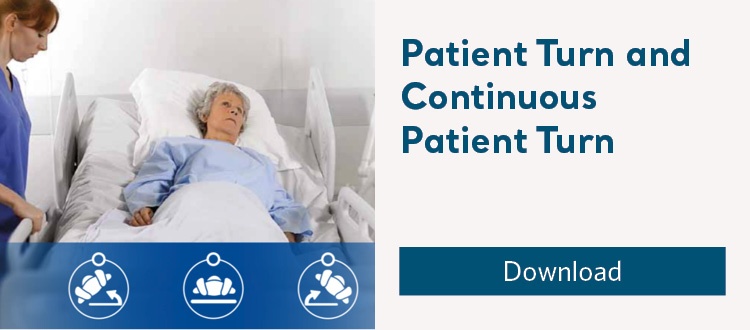Movement, be it spontaneous and independent or physically assisted by others, is arguably the pivotal protective mechanism by which an individual avoids the risk of pressure injuries. Although multi-factorial in their origin, by definition pressure injuries cannot occur without loading or pressure on the tissues.1 There are many harmful effects of these wounds, but a wide range of technologies available today can aid in their prevention and treatment (Learn more in our article "5 pressure injury prevention technologies.")
"One of the cornerstones of pressure injury prevention is patient repositioning.2 When performed manually, it brings significant risks to caregivers."3
Risks of manual repositioning of patients
While routine manual repositioning of patients is deemed an important aspect of prevention in many care settings, this practice simultaneously exposes caregivers to an activity both physically demanding and time consuming. In fact, manual patient handling is considered the largest risk factor for overexertion injuries in healthcare workers.3 Included among the risk factors are:
- The physical weight of the patient and the effort required
- Sudden unexpected movements
- Bending, twisting and adverse posture4 affecting the spine and joints
- The duration of load-bearing postures
- Lateral positioning (pre-turn) involves higher strain than turning5
- Repetition: several times each shift for each patient requiring assistance
“60% of caregiver injuries are related to physical repositioning in bed, such as turning, boosting and transfers.”6
Assistance with patient repositioning
The Citadel Patient Care System was designed to assist caregivers with lateral patient repositioning through the use of two key features:
1. Patient Turn and Hold
By using the integrated surface option on the Citadel Patient Care System caregivers are assisted to perform lateral patient turn of up to 20 degrees with the press of a button. Beds with an integrated low angle rotation function have been shown to reduce exposure to the detrimental effects of pressure, while maintaining a comfortable and secure posture for the patient7,8
2. Continuous Patient Turn
The Citadel Patient Care System also provides a continuous low-angle patient turn function, which can complement or supplement routine repositioning. By automating the rotation sequence, pressure can be redistributed several times each hour; a frequency that closely approximates to that observed in normal spontaneous movement9 whilst reducing the physical demands on caregivers.

The benefits for caregivers using repositioning aids
Using repositioning aids to facilitate nursing interventions has a number of health benefits. Utilising biomechanically optimised handling modes supplemented by small, technical aids reduces the load on a caregiver’s spine and can achieve a reduction in lumbar-overload risk during manual patient handling procedures.10 Moreover, nurses who routinely deploy assistive equipment when handling patients suffer fewer musculoskeletal disorders (MSDs).11
In addition, having access to a bed with a Patient Turn feature is convenient, always being available to assist with lateral rotation of the patient. To learn more about the benefits and solutions the Citadel Patient Care System may bring to patients, caregivers, and healthcare providers alike, please download our whitepaper below:
If you would like to discuss your specific concerns for how to provide improved patient repositioning and pressure injury prevention, please find the contact information for your local Arjo representative here.
References
1. National Pressure Ulcer Advisory Panel, European Pressure Ulcer Advisary panel and Pan Pacific Pressure Injury Alliance. Prevention and Treatment of Pressure Ulcers: Clinical Practice Guideline. Emily Haesler (Ed.). Cambridge Media: Osborne Park, Western Australia; 2014. Page 89
2. Phillips L. Pressure ulcer prevention: keep it safe, keep it simple. In: Duffy V, Lightner N (eds). Advances in Human Aspects of Healthcare. Proceedings Applied Human Factors and Ergonomics: USA. 2014; 3: 19-24
3. Humrickhouse R, Knibbe HJJ. The Importance of Safe Patient Handling to Create a Culture ofSafety: An Evidential Review, The Ergonomics Open Journal. 2016; 9: 27-42
4. Yassi A, Lockhart K. Work-relatedness of low back pain in nursing personnel: A systematic review. International Journal of Occupational and Environmental Health. 2013: 19(3), 223–244.
5. Wiggerman N. Biomechanical Evaluation of a Bed Feature to Assist in Turning and Laterally Repositioning Patients. Human Factors. 2016; 58(5): 748-757
6. McCoskey KL. Ergonomics and patient handling. AAOHN Journal, 2007; 55(11): 454-462
7. Do NH, Kim DY), Jung-Hoon Kim J-H et al. Effects of a continuous lateral turning device on
pressure relief. J. Phys. Ther. Sci. 2016; 28: 460–466
8. Yi C-H, Kim H-S, Yoo W-G. The Effects of Different Types of Automated Inclining Bed and Tilt
Angle on Body-Pressure Redistribution. Adv Skin Wound Care. 2009; 22: 259 – 264
9. Reenalda J, Van Geffen P, Nederhand M. Analysis of healthy sitting behavior: Interface pressure distribution and subcutaneous tissue oxygenation. Journal of Rehabilitation Research & Development. 2009; 46(5): 577-586
10. Matthias Jäger, Claus Jordan, Andreas Theilmeier, Norbert Wortmann, Stefan Kuhn, Albert Niehaus and Alwin Luttmann. Lumbar-Load Analysis of Manual Patient-Handling Activities for Biomechanical Overload Prevention Among Healthcare Workers. Ann. Occup. Hyg., Vol. 57, No. 4, pp. 528–544, 2013
11. Andersen LL, Burdorf A, Fallentin N et al. Patient transfers and assistive devices: prospective cohort study on the risk for occupational back injury among healthcare workers. Scand J Work Environ Health 2014; 40(1): 74-81
